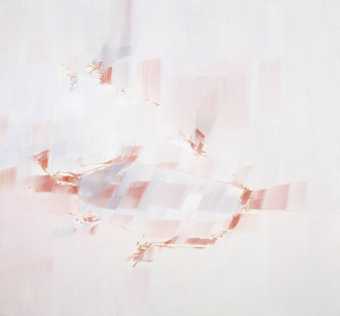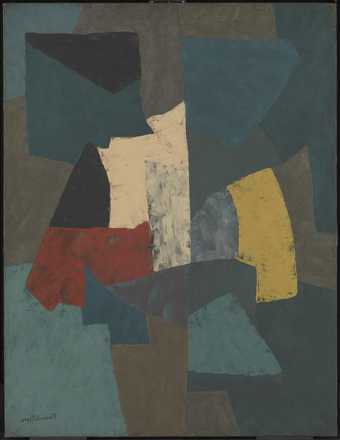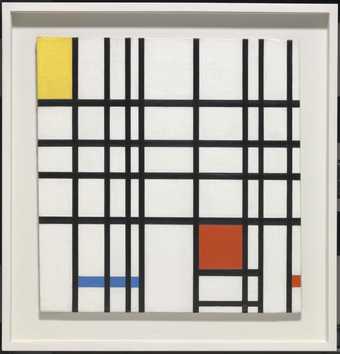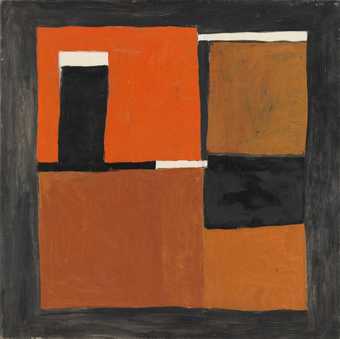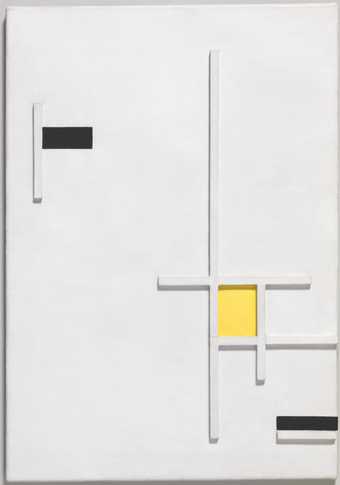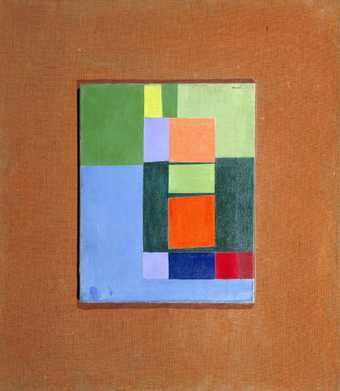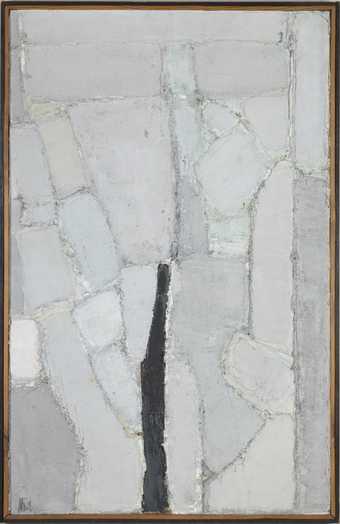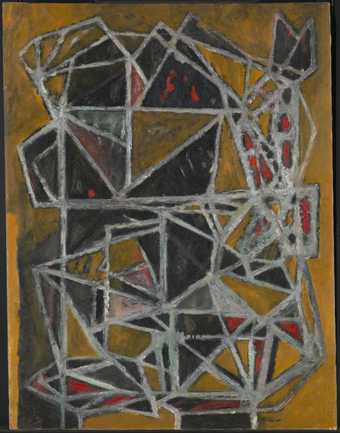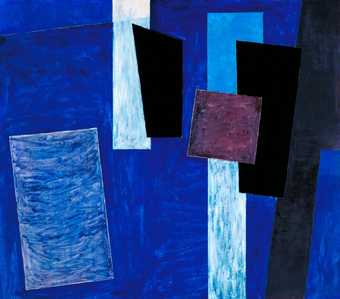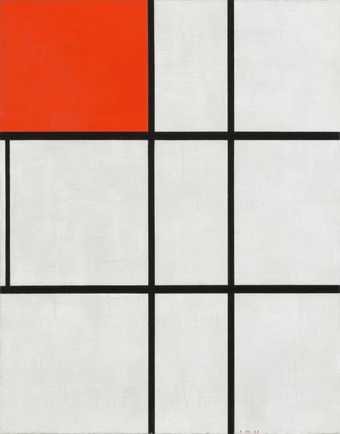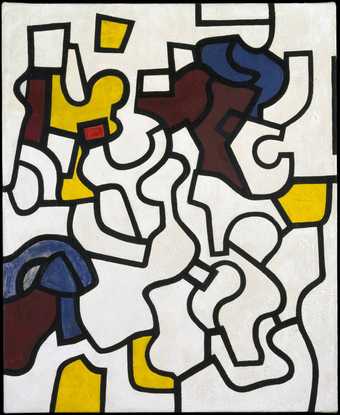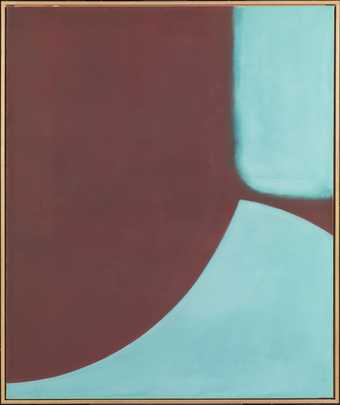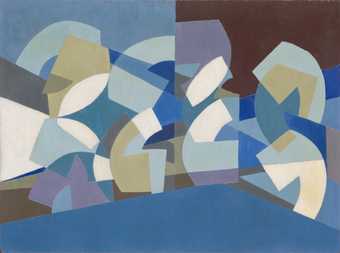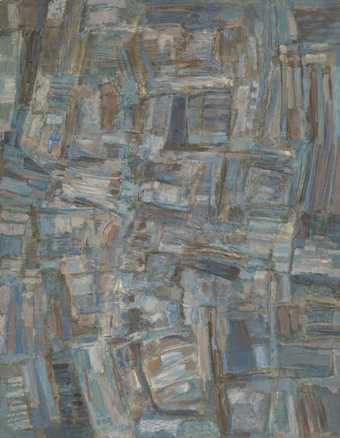
In Tate Modern
- Artist
- Saloua Raouda Choucair 1916–2017
- Medium
- Oil paint on canvas
- Dimensions
- Support: 500 × 1850 mm
- Collection
- Tate
- Acquisition
- Purchased with funds provided by the Middle East North Africa Acquisitions Committee 2014
- Reference
- T14002
Summary
Composition with Two Ovals 1951 is an abstract painting on a large, horizontally orientated rectangular canvas. It is a prime example of Choucair’s abstract paintings from this period in its use of primary colours and a system of bold geometric forms. Interlocking abstract volumes are characteristic of the artist’s work in general, and particularly define the period she spent living in Paris in the late 1940s, when she was exposed to abstraction in painting through the Atelier de l’Art Abstrait and furthered her study of geometric motifs and architectural compositions. Although this painting exemplifies Choucair’s characteristic curved, closed forms, geometry of line, repetition of modules and formally tight compositions, it can also be seen as a pivotal departure from the rest of her works in its large size, elongated shape and distinctive colour palette of red, green, yellow, black and white. At the same time, the work embodies the complexity and formal exploration that marks Choucair’s production as a whole and which is also found in her Composition in Blue Module 1947–51 (Tate T13308).
Despite the title, in Composition with Two Ovals the ovoid forms seem to disappear, dominated by the emergence of squares, polygons and lines. Almost as if colliding with each other, the two abstracted ovals are depicted in a multiplicity of diverse forms and colours. Their autonomous movements articulate an expression of motion, appearing to revolve around a dark void at the centre of the composition. This sense of movement is offset by a system of formal unity and structural balance, creating a rhythm and harmony within the painting as a whole.
Choucair began working in her native Lebanon in the 1940s, a lone female voice in Beirut’s art scene at the time. Her early work was informed by her interest in and understanding of Islamic forms in art and architecture. Working across painting and sculpture, she combined this exploration of abstract forms with an understanding of traditional Sufi philosophy and literature. Throughout her career, she has experimented with materials and diverse means of production, exploring both figuration and abstraction, as well as seriality and dynamism within her multi-part sculptures (see, for example, Infinite Structure 1963–5, Tate T13262). Since the 1960s she has also produced more functional sculptural pieces such as fountains and benches, some of which have become part of Beirut’s urban landscape.
Further reading
Joseph Tarrab (ed.), Saloua Raouda Choucair: Her Life and Art, Beirut 2002.
Jessica Morgan (ed.), Saloua Raouda Choucair, exhibition catalogue, Tate Modern, London 2013.
Vassilis Oikonomopoulos
July 2013
Does this text contain inaccurate information or language that you feel we should improve or change? We would like to hear from you.
Display caption
Choucair is one of the few Lebanese artists of her generation devoted to geometric abstraction. Her approach developed in response to two distinct influences: Islamic art and the avant-garde art scene of Paris in the 1940s, where she was a student. Like many of her paintings, it uses the two basic elements of Islamic design – the straight line and the curve – as a starting point to create simple shapes which she places in rhythmic dialogue.
Gallery label, November 2015
Does this text contain inaccurate information or language that you feel we should improve or change? We would like to hear from you.
Explore
- abstraction(8,615)
-
- non-representational(6,161)
You might like
-
Sergio Romiti Composition
1960 -
Serge Poliakoff Abstract Composition
1954 -
Piet Mondrian Composition with Yellow, Blue and Red
1937–42 -
William Scott Orange, Black and White Composition
1953 -
Marlow Moss Composition in Yellow, Black and White
1949 -
Kenneth Martin Composition
1949 -
Nicolas de Stael Composition 1950
1950 -
William Gear Composition
1949 -
Adrian Heath Composition, Blue, Black and Brown
1952 -
Piet Mondrian Composition B (No.II) with Red
1935 -
Judith Rothschild Untitled Composition
1945 -
Marc Vaux Composition: Red and Green
1960 -
Saloua Raouda Choucair Composition in Blue Module
1947–51 -
Shafic Abboud Composition
c.1957–8 -
Anwar Jalal Shemza Composition in Red and Green, Squares and Circles
1963

